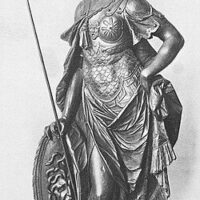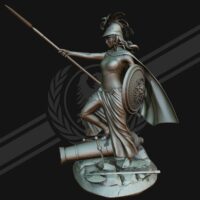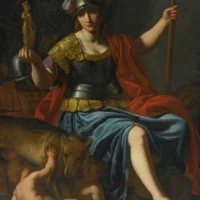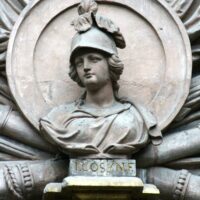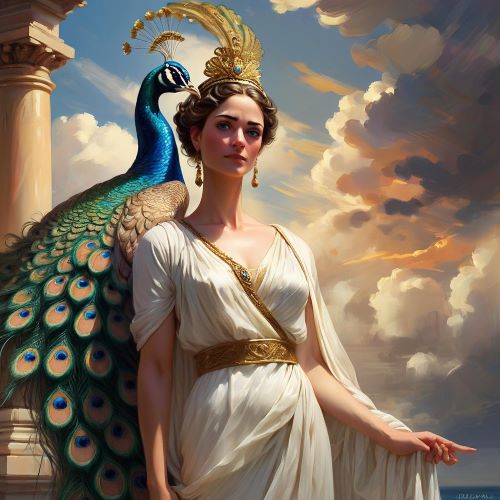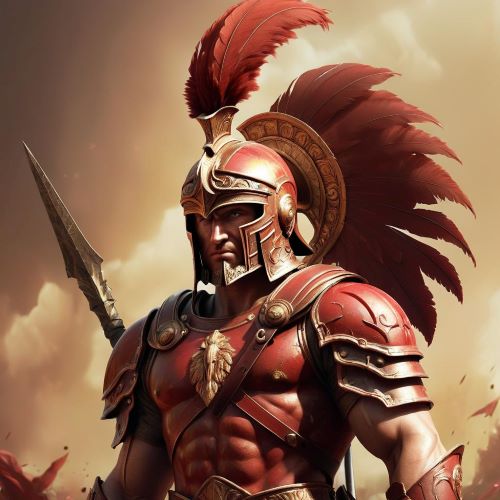Bellona : Goddess of War
Listen
At a glance
| Description | |
|---|---|
| Origin | Roman Mythology |
| Classification | Gods |
| Family Members | Mars (Brother) |
| Region | Italy |
| Associated With | War |
Bellona
Introduction
Bellona was the formidable Roman goddess of war, destruction, and conquest. Known for her fierce presence in both myth and ritual, she represented not just military might but the very essence of battle itself—chaos, fury, and bloodlust. As a divine embodiment of Rome’s martial spirit, she was a source of inspiration and reverence for soldiers and generals, often invoked in times of conflict to bring victory and terror to the battlefield.
While Mars is typically remembered as Rome’s primary war deity, Bellona held a distinct and equally potent role. She embodied the unrestrained aggression and psychological fervor of combat, making her one of the most fearsome deities in the Roman pantheon.
Physical Traits
Bellona is typically envisioned as a striking figure of war, often clad in armor with a plumed helmet. She is frequently portrayed wielding a sword, spear, or shield—symbols of her combative nature. A blood-red torch or whip sometimes accompanies her, hinting at her association with fire and destruction.
Art from later periods, especially the Renaissance, emphasized her dramatic and intimidating presence. In many of these depictions, she rides into battle on a chariot drawn by four horses, a detail that underscores her commanding and dynamic role in warfare. Some artists gave her Gorgon-faced shields or helmets, borrowing from Greek imagery to heighten her terror-inducing aesthetic. The blend of raw power and divine femininity in these portrayals cemented Bellona as a striking icon of war.
Family
In Roman mythology, Bellona’s family ties are closely linked to the principal deities of Olympus. She is commonly regarded as the daughter of Jupiter and Juno, placing her among the divine elite. Her connection to Mars is especially notable—variously described as his sister, consort, or even his female counterpart.
This close association with Mars underscores her integral role in Rome’s religious and military traditions. While Mars often symbolized military strategy and valor, Bellona represented the visceral, frenzied side of battle. Together, they embodied the dual aspects of war: calculated strength and chaotic violence.
Other names
Bellona was originally known by the older Latin name Duellona, derived from duellum, an archaic word for war. Over time, as the Latin language evolved, bellum became the standard term for war, and so Duellona became Bellona—a name that survives in modern words like “belligerent” and “bellicose.”
In Greek mythology, her closest equivalent is Enyo, a war goddess who delighted in the destruction of cities and the slaughter of enemies. Bellona is also associated with the Anatolian goddess Ma, whose worship spread through the Roman Empire and who shared similar warlike attributes. These cross-cultural connections enriched Bellona’s identity, blending native Roman traditions with external influences.
Powers and Abilities
As a deity of war, Bellona possessed a wide range of supernatural powers. She could incite madness and bloodlust in warriors, fueling their rage and courage in battle. Her presence was believed to electrify armies, pushing them to fight with unrelenting ferocity.
One of the most distinctive aspects of Bellona’s worship was the practice of ritual bloodletting. Her priests, known as Bellonarii, would gash their own bodies as offerings during ceremonies, sometimes using their blood to anoint altars or sacred objects. This intense devotion reflected the belief that Bellona thrived on violent displays of loyalty and sacrifice.
Strategic influence was also within her domain. While Mars might be called upon for honor and military organization, Bellona offered the raw, instinctual energy needed in the heat of battle. In myth and popular storytelling, she is seen leading charges, whipping up storms of chaos, and tipping the scales in favor of those who honored her properly.
Modern adaptations, such as in the “Camp Half-Blood” universe, have expanded her abilities into more fantastical realms—like controlling weapons telekinetically, conjuring fire, or manipulating blood. These interpretations keep her relevant to younger audiences while preserving her essential characteristics.
Modern Day Influence
Though worship of Bellona faded with the fall of Rome, her legacy lives on in multiple areas of contemporary culture. Her name has been given to a minor planet—28 Bellona—discovered in the 19th century, highlighting her influence in science and astronomy. In literature and the arts, she continues to appear as a symbol of war’s brutal beauty and feminine power.
During the Renaissance, artists like Rembrandt painted her as a striking figure of martial elegance. In his 1633 work, Bellona is depicted wearing ornate armor and standing resolute, exuding both nobility and menace. Writers, including William Shakespeare, referenced her to evoke the wrath of battle. In Macbeth, for example, Bellona’s name is invoked to amplify the savagery of the Scottish hero’s military prowess.
Beyond traditional art and literature, Bellona also has a presence in memorial architecture. Statues, fountains, and war monuments bearing her image can be found across Europe and the Americas. These public tributes serve both as artistic expressions and as somber reminders of the price of warfare. The Bellona Fountain in Warsaw, Poland, and the Gallipoli memorial bust by Bertram Mackennal in Australia are just a few examples where she is immortalized in stone and bronze.
In recent years, Bellona has also been reinterpreted through feminist and psychological lenses. As a divine figure who defied traditional gender roles by embracing aggression and strength, she has become a symbol of empowered femininity. Some art therapy and peace-building programs have even used her mythology to explore the themes of conflict resolution, trauma, and the inner warrior archetype in both men and women.
Related Images
Source
Contributors to Wikimedia projects. (2005). Bellona (goddess) – Wikipedia. https://en.wikipedia.org/wiki/Bellona_(goddess)
Lloyd-Morgan, Glenys. Nemesis and Bellona,” in The Concept of the Goddess, Routledge, 1996.
Poplacean, Danielle. The Business of Butchery: Bellona and war, society and religion from republic to empire (Thesis), 2018.
Orlin, Eric. Routledge Encyclopedia of Ancient Mediterranean Religions, Routledge, 2015.
de Vaan, Michiel. Etymological Dictionary of Latin and the other Italic Languages, Brill, 2008.
Smith, William. Dictionary of Greek and Roman Biography and Mythology, London, 1870.
Bellona | Goddess of War, Roman Mythology, Goddess of Victory. (2025). https://www.britannica.com/topic/Bellona
ENYO – Greek Goddess of War (Roman Bellona). (2000). https://www.theoi.com/Daimon/Enyo.html
Frequently Asked Questions
What is lorem Ipsum?
I am text block. Click edit button to change this text. Lorem ipsum dolor sit amet, consectetur adipiscing elit. Ut elit tellus, luctus nec ullamcorper mattis, pulvinar dapibus leo.
What is lorem Ipsum?
I am text block. Click edit button to change this text. Lorem ipsum dolor sit amet, consectetur adipiscing elit. Ut elit tellus, luctus nec ullamcorper mattis, pulvinar dapibus leo.
What is lorem Ipsum?
I am text block. Click edit button to change this text. Lorem ipsum dolor sit amet, consectetur adipiscing elit. Ut elit tellus, luctus nec ullamcorper mattis, pulvinar dapibus leo.
What is lorem Ipsum?
I am text block. Click edit button to change this text. Lorem ipsum dolor sit amet, consectetur adipiscing elit. Ut elit tellus, luctus nec ullamcorper mattis, pulvinar dapibus leo.
What is lorem Ipsum?
I am text block. Click edit button to change this text. Lorem ipsum dolor sit amet, consectetur adipiscing elit. Ut elit tellus, luctus nec ullamcorper mattis, pulvinar dapibus leo.



